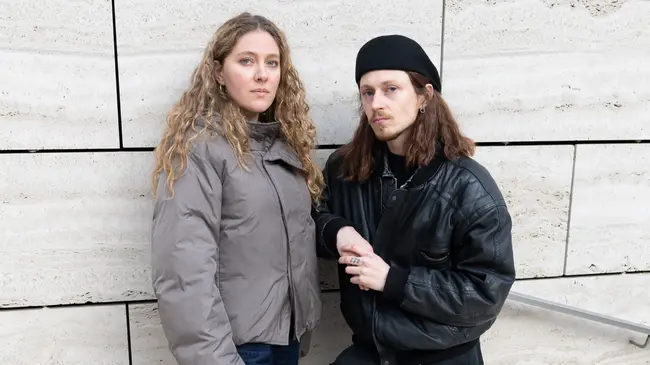Breaking free from a realistic representation of the human form

Her name may not sound Flemish - and she’s in fact of British descent - but Amber Andrews’s practice is rooted in her hometown of Antwerp, the same city to which all 24 different artists exhibited in M HKA’s Museum in Motion have links to. We let her highlights carry our conversation and discussed what makes her tick, how she stays curious, and why she has a love for language.
What surprised you the most about your visit to Museum in Motion?
Nowadays we are constantly behind screens, so in a museum context, I’m usually not drawn to video. However, the archival footage of Gordon Matta Clark’s site-specific interventions caught my attention because it reveals his intensive process. And the way in which Andrea Fraser plays with satire and humour in the series of filmed performances she wrote and directed was brilliant. I was also happy to discover that M HKA’s collection holds works by Nicola L. such as the Giant Foot sculpture. Besides being functional, her designs are also fun. There’s an ease to them which I find satisfying.
Walter Swennen’s paintings also seemed to spark food for thought.
I really appreciate the way in which Swennen speaks about painting because it conveys full admiration for the medium and I aspire to do the same. He once said that painting is a necessity to stay curious. Seeing as my work is highly figurative and is therefore inherently easier to navigate, I try to break free from a realistic representation of the human form and instead really focus on working with the paint. That’s what keeps me curious.
I appreciate the way in which Swennen speaks about painting, it conveys full admiration for the medium
Have you ever considered coming away from the canvas and exploring other mediums?
I want to keep evolving in my painting, but not limit myself to it. My practice is driven by the exploration of ideas and aesthetics, so I can implement these in other ways. For my upcoming show, I’m making jar-shaped pouffes with embroidered cushions to sit on. They were conceived following research into how women of Greek mythology have been misinterpreted due to inaccurate translations. For example, I discovered that the ‘box’ associated with Pandora’s myth was actually a jar and its contents may have just poured out by accident. The idea of sitting on a jar is a bit ridiculous, but I see it as an intervention that can bring a new layer to the show.
My practice is driven by the exploration of ideas and aesthetics
You often depict domestic environments in your work, so bringing physical seats into your next show is an exciting prospect.
I like chairs in particular as objects that carry something. Funny how in the installation by Haegue Yang’s VIP's Union the chair I liked the most was lent by Johan Pas, my art history teacher and dean of the Royal Academy of Fine Arts Antwerp. I think I would have liked it more in a colour rather than in black though!
On that note, could you tell me about the group show Palai you were involved in last year? Your paintings seemed to really come alive against the colourful walls of the Apulian palazzo.
Ah, this was really a match made in heaven: I was totally in awe. I’d love to recreate that kind of setting in a gallery, but not in a gimmicky way. Two artists that do this really well are Nicolas Party and Cristoph Ruckhäberle, who create total environments by juxtaposing their work against hectic colours or patterns. I don’t subscribe to the ‘less is more’ mentality, but I know ‘more is more’ is not always appropriate! I’m still learning [laughs].
I don’t subscribe to the ‘less is more’ mentality
I noticed how in some cases the titles of your paintings are descriptive and in others, they seem to speak to a whole other story. Is this intentional?
I like titles to act as additional leads in my painting. I have a whole collection of weird sentences I’ve written down because language strongly evokes visuals for me. I note things whilst listening to music, reading or tuning into a stranger’s conversation. I also saved so many funny things my English grandmother has said, in true British humour. I think the English language has so many catchy phrases. My last show was titled You scratch my back, I’ll scratch yours. This immediately brought a visuality which, in my opinion, is stronger than trying to find one direct association to a body of work. I never use Untitled, and if I can’t come up with a title I feel bad for the painting. I mean, you always name your children!
What would you like viewers to come away with after seeing your work?
One of the best compliments I received from someone who purchased a painting was that it kept growing on them as time went by, continuously revealing new things. I want my artworks to hold multiple narratives, so viewers should always construct their own meaning. Unless it’s my mother; then I feel compelled to correct her if she’s misreading an image! [laughs]
Different Class works with the interest of their community at heart.
Our work’s purpose is to foster a solid network for independent artists, those who love them, and those who want to support them. Become a member to contribute to the local Belgian art scene.





